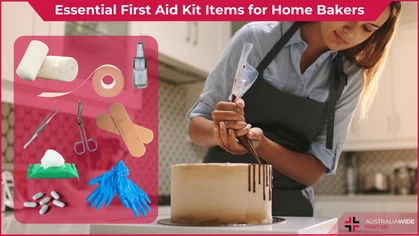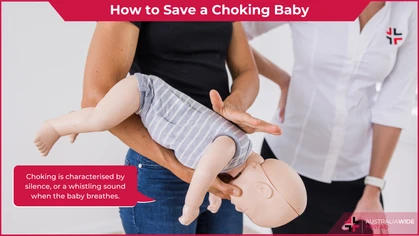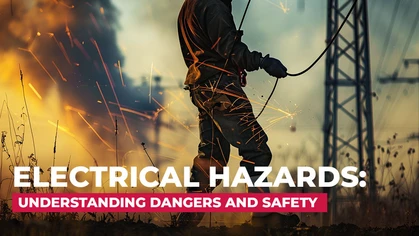Common Workout Injuries and How to Prevent Them

Danger
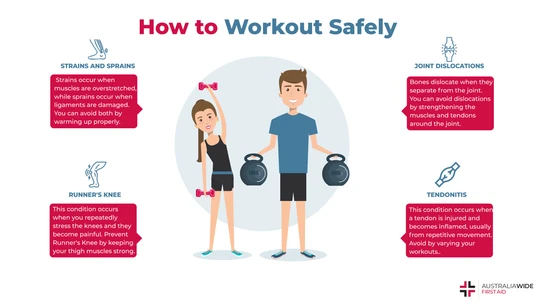
Regular exercise makes you mentally sharp and happy but your physical body sometimes suffers. If you have aches and pains, slow down or stop, and let yourself rest and recover.
Exercise injury occurs when physical harm or damage is done to one or multiple parts of your body, for example, when you twist your foot when jumping, thus damaging your ankle, or put too much weight on the barbell and pull a muscle in your lower back. The injury can be caused by a single event during exercise (fall), or sustained over a longer period (wear and tear of a tendon tissue). Exercising is important for our overall well-being because it keeps us mentally and physically healthy. Many of us like challenging ourselves to see what we are capable of (it feels good, too!). However, it's important to be wary of injuries, as they can lead to ongoing complications. This 14-year-long study on injuries sustained in fitness facilities found that the main cause of injuries is due to overexertion (both in the free weights area and group exercise classes). Today we look at common workout injuries, what exercises or activities cause them, and how to prevent them and workout safely.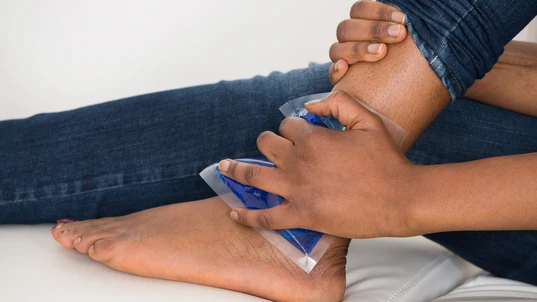
A sprain occurs when the strong ligaments stretch beyond their limit and tear. You often see swelling and bruising of the affected area.
Strains and sprains
We often use those two terms interchangeably but they don’t have the same meaning. A strain occurs when the muscle is overstretched or torn and the tendon is affected (tendon attaches bone to muscle). We should call it muscle pull. Strains can happen in any muscle however they most commonly occur in:- Hamstrings (back of thigh);
- Quadriceps (front of thigh);
- Groin muscles (between stomach and thigh);
- Lower back;
- Rotator cuff (shoulder);
- Knees;
- Elbows;
- Wrists;
- Shoulders;
- Ankles;
Stress fractures
A stress fracture may happen if you push through the pain of a strain or sprain and the bone becomes vulnerable to damage. You are at a higher risk if you play contact sports or do high-impact training (for example, bodyweight HIIT classes or heavy lifting), Bone fractures most commonly occur in:- Arms;
- Legs;
- Feet;
Joint dislocations
A dislocation occurs when two bones get separated where they meet at a joint. It could happen when you collide with someone and fall on your arm heavily when you play sports, or when you exercise in the gym with too much weight and incorrect technique. For example, incorrectly performed barbell shoulder press sometimes leads to dislocated shoulder when the top of your arm slips out of your shoulder joint and it can move in any direction. You can dislocate almost any joint:- Knee;
- Hip;
- Ankle;
- Elbow;
- Jaw;
- Finger and toe joints;
Plantar fasciitis and shin splints
Plantar fasciitis and shin splints are not the same conditions but they are both injuries of those who walk and/or run a lot. Plantar fasciitis is inflammation of the muscle on the bottom of the foot. This happens as a result of overuse (remember the time when you had to walk all day and the bottoms of your feet were sore afterwards?). Plantar fasciitis can be prevented by stretching your feet and arches before running and by investing in high-quality shoes. You know you have shin splints when you feel pain just above the ankle along the bone in the front of your leg and this pain stops when you stop walking or slow down. Shin splints are not a chronic condition - you will stop getting them when the stress is over. Some of the ways to prevent shin splints are:- Stretching calves and hamstrings.
- Increasing activity gradually and not doing too much if you know your body is not prepared.
- Exercising (running) on soft surfaces so that your body absorbs less shock. Less shock = less pain afterwards.
- Hip strengthening - strong hip muscles can absorb that shock, too, thus taking it off your lower legs and feet.
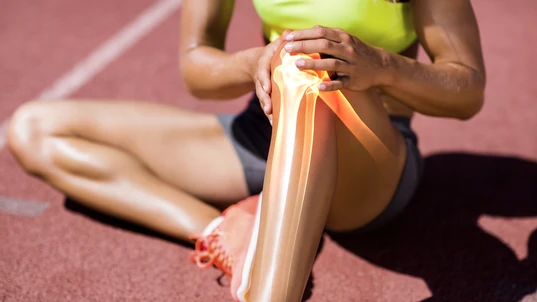
Even though Runner’s Knee is a common injury among runners, it can happen to anyone who is into cycling, skiing, playing football, and even going to the gym and group exercise classes.
Runner’s Knee (Patellofemoral Pain Syndrome)
Runner’s knee is dull pain around the front of the knee and is called a Patellofemoral Pain Syndrome. Even though the name suggests that it is a runners’ injury, it is not just that. Anyone who does activities that repeatedly stress the knees can get Runner’s Knee symptoms. For example, cycling, playing football, or skiing. Exercises like lunges or jumping can cause that, too. To prevent Runner’s Knee:- Keep your thigh muscles strong.
- Keep a healthy weight.
- Invest in appropriate shoes.
- Run or exercise on softer surfaces.
- Progress your exercise routine gradually.
Tendonitis
Tendonitis is a swelling and inflammation of a tendon after it is injured. The most common injury causes are overuse and repetitive movement and the main symptoms are joint pain and stiffness. Tendonitis can occur in any of the tendons but the most common sites are:- Shoulders (called Swimmer’s shoulder - one of the rotator cuff tendons is inflamed).
- Elbows (Tennis elbow - affects outer side of the elbow; Golfer’s elbow - affects inner side of the elbow).
- Wrists (De Quervain’s syndrome - back of the wrist).
- Knees (Jumper’s knee - front of the knee).
- Heels (Achilles tendonitis - back of the ankle & heel).
Conclusion
Most injuries can be prevented by simply following the guidelines and rules on how to protect yourself when you play sports, do bodyweight exercises or train with weights in the gym. Some of the best ways to minimise the risk of any injury are to:- Improve your full body strength so that your muscles, ligaments and tendons are less likely to get strained or sprained.
- Switch up your exercise routine to avoid or delay wear and tear injuries such as tendonitis.
- Avoid training when you are tired and let your body rest and recover instead.
Originally published at
https://www.australiawidefirstaid.com.au/resources/common-workout-injuries
as part of the Australia Wide First Aid Articles Library




